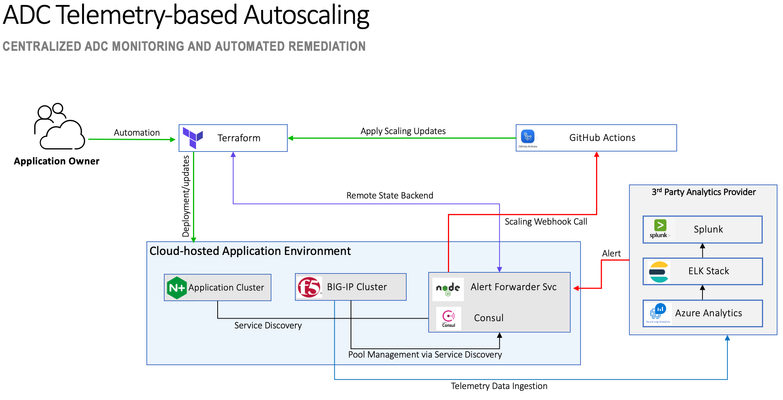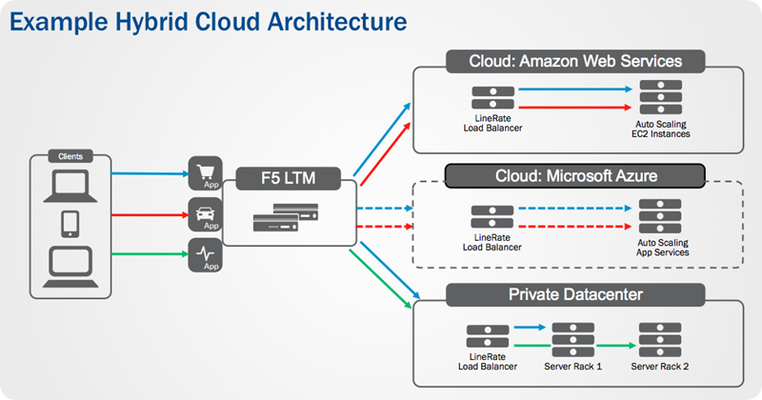auto scaling
3 TopicsCloud Scaling without Native Cloud Scaling
Planning and configuring scaling for a multi cloud-hosted application is not without its challenges and limitations. When I consider the unique approach each public cloud (AWS, Azure, GCP, etc.) has when it comes to scaling of VM instances, applying a consistent scaling policy across the application environment can be difficult. The difficulty level goes up even more when you want to automate your deployment. Aside from the inherent challenge of working with disparate cloud environments, my options with regard to scaling policies and the metrics used to trigger scaling events are limited when attempting to apply consistently across clouds. With the F5 BIG-IP and Telemetry Streaming I have the ability to send a variety of metrics to both CloudWatch and Azure Monitor. From there I could use custom metrics from each respective cloud. But now, I've only succeeded in complicating the solution, (as well as spraying logs all over the place). To address the challenges noted above allow me to introduce... The ADC Telemetry-based Autoscaling (ATA) solution, (see above) illustrates how F5's Automation Toolchain can integrate with third party analytics provider(s) to provide cloud-agnostic centralized application delivery monitoring and autoscaling. The solution utilizes various third-party open-source and proprietary technologies/services and the concept could easily be applied using a variety of vendor offerings. With that said, this solution utilizes the following: F5 BIG-IP(s) providing L4/L7 ADC Services F5 Declarative Onboarding, (DO) and Application Services 3 Extension, (AS3) to deploy to configure BIG-IP application services F5 Telemetry Streaming, (TS) to stream telemetry data to a third party analytics provider Hashicorp Terraform and Consul for infrastructure provisioning, service discovery and event logging GitHub Actions for workflow automation Azure and/or AWS public clouds for application hosting Third-party Analytics Provider, (integrated with BIG-IP(s) via TS) for monitoring and alerting Check it Out Rather than walk you through the entire solution in agonizing detail, how about a movie? Click on the link (image) below for a solution walkthrough. Try it Out Okay, so you watched the video and can't wait to try it in action; I get it. The GitHub solution repository contains guidance as well as the necessary files to deploy the solution. Have fun!614Views1like0CommentsApplication Auto Scaling Through BIG-IP Cloud Edition
Peanut butter is good and jelly is good. What happens when you bring those two together? BIG-IQ 6 is the peanut butter, Per App VE is the jelly. Put them together and you get per application auto scaling. BIG-IP supported auto scaling for a while now but the use cases of dynamically deploying multiple instances of BIG-IP were few (based on individual application requirements). By deploying the BIG-IP Per App VE instead, you get a (marketing speak alert) lower cost deployment for customized ADC and security on a per application basis. Our training team put together a great walk-through article for deploying auto scaling features with BIG-IP Cloud Edition. In our two videos we're deploying auto scaling functionality into VMWare and AWS infrastructures. For comparison go back and check out Skies Never looked So Good With BIG-IP Cloud Edition where we show the differences between AWS and VMWare tier 1 traffic distributors. But enough talk... Enjoy the walk-through. A discussion in Q&A for BIG-IP Cloud Edition is available if you have questions. Further Reading ASKF5 BIG-IP Cloud Edition Knowledge Center BIG-IP Cloud Edition - Deploy and Secure an Application BIG-IP Cloud Edition & Per App VE FAQ Getting In Shape For Summer With BIG-IP Per App Virtual Edition ASKF5 K33431282: Overview of BIG-IP Cloud Edition Components896Views0likes0CommentsCloud bursting, the hybrid cloud, and why cloud-agnostic load balancers matter
Cloud Bursting and the Hybrid Cloud When researching cloud bursting, there are many directions Google may take you. Perhaps you come across services for airplanes that attempt to turn cloudy wedding days into memorable events. Perhaps you'd rather opt for a service that helps your IT organization avoid rainy days. Enter cloud bursting ... yes, the one involving computers and networks instead of airplanes. Cloud bursting is a term that has been around in the tech realm for quite a few years. It, in essence, is the ability to allocate resources across various public and private clouds as an organization's needs change. These needs could be economic drivers such as Cloud 2 having lower cost than Cloud 1, or perhaps capacity drivers where additional resources are needed during business hours to handle traffic. For intelligent applications, other interesting things are possible with cloud bursting where, for example, demand in a geographical region suddenly needs capacity that is not local to the primary, private cloud. Here, one can spin up resources to locally serve the demand and provide a better user experience. Nathan Pearce summarizes some of the aspects of cloud bursting in this minute long video, which is a great resource to remind oneself of some of the nuances of this architecture. While Cloud Bursting is a term that is generally accepted by the industry as an "on-demand capacity burst," Lori MacVittie points out that this architectural solution eventually leads to a Hybrid Cloud where multiple compute centers are employed to serve demand among both private-based resources are and public-based resources, or clouds, all the time. The primary driver for this: practically speaking, there are limitations around how fast data that is critical to one's application (think databases, for example) can be replicated across the internet to different data centers. Thus, the promises of "on-demand" cloud bursting scenarios may be short lived, eventually leaning in favor of multiple "always-on compute capacity centers" as loads increase for a given application. In any case, it is important to understand that that multiple locations, across multiple clouds will ultimately be serving application content in the not-too-distant future. An example hybrid cloud architecture where services are deployed across multiple clouds. The "application stack" remains the same, using LineRate in each cloud to balance the local application, while a BIG-IP Local Traffic Manager balances application requests across all of clouds. Advantages of cloud-agnostic Load Balancing As one might conclude from the Cloud Bursting and Hybrid Cloud discussion above, having multiple clouds running an application creates a need for user requests to be distributed among the resources and for automated systems to be able to control application access and flow. In order to provide the best control over how one's application behaves, it is optimal to use a load balancer to serve requests. No DNS or network routing changes need to be made and clients continue using the application as they always did as resources come online or go offline; many times, too, these load balancers offer advanced functionality alongside the load balancing service that provide additional value to the application. Having a load balancer that operates the same way no matter where it is deployed becomes important when resources are distributed among many locations. Understanding expectations around configuration, management, reporting, and behavior of a system limits issues for application deployments and discrepancies between how one platform behaves versus another. With a load balancer like F5's LineRate product line, anyone can programmatically manage the servers providing an application to users. Leveraging this programatic control, application providers have an easy way spin up and down capacity in any arbitrary cloud, retain a familiar yet powerful feature-set for their load balancer, ultimately redistribute resources for an application, and provide a seamless experience back to the user. No matter where the load balancer deployment is, LineRate can work hand-in-hand with any web service provider, whether considered a cloud or not. Your data, and perhaps more importantly cost-centers, are no longer locked down to one vendor or one location. With the right application logic paired with LineRate Precision's scripting engine, an application can dynamically react to take advantage of market pricing or general capacity needs. Consider the following scenarios where cloud-agnostic load balancer have advantages over vendor-specific ones: Economic Drivers Time-dependent instance pricing Spot instances with much lower cost becoming available at night Example: my startup's billing system can take advantage in better pricing per unit of work in the public cloud at night versus the private datacenter Multiple vendor instance pricing Cloud 2 just dropped their high-memory instance pricing lower than Cloud 1's Example: Useful for your workload during normal business hours; My application's primary workload is migrated to Cloud 2 with a simple config change Competition Having multiple cloud deployments simultaneously increases competition, and thus your organization's negotiated pricing contracts become more attractive over time Computational Drivers Traffic Spikes Someone in marketing just tweeted about our new product. All of a sudden, the web servers that traditionally handled all the loads thrown at them just fine are getting slashdotted by people all around North America placing orders. Instead of having humans react to the load and spin up new instances to handle the load - or even worse: doing nothing - your LineRate system and application worked hand-in-hand to spin up a few instances in Microsoft Azure's Texas location and a few more in Amazon's Virginia region. This helps you distribute requests from geographically diverse locations: your existing datacenter in Oregon, the central US Microsoft Cloud, and the east-coast based Amazon Cloud. Orders continue to pour in without any system downtime, or worse: lost customers. Compute Orchestration A mission-critical application in your organization's private cloud unexpectedly needs extra computer power, but needs to stay internal for compliance reasons. Fortunately, your application can spin up public cloud instances and migrate traffic out of the private datacenter without affecting any users or data integrity. Your LineRate instance reaches out to Amazon to boot instances and migrate important data. More importantly, application developers and system administrators don't even realize the application has migrated since everything behaves exactly the same in the cloud location. Once the cloud systems boot, alerts are made to F5's LTM and LineRate instances that migrate traffic to the new servers, allowing the mission-critical app to compute away. You just saved the day! The benefit to having a cloud-agnostic load balancing solution for connecting users with an organization's applications not only provides a unified user experience, but provides powerful, unified way of controlling the application for its administrators as well. If all of a sudden an application needs to be moved from, say, a private datacenter with a 100 Mbps connection to a public cloud with a GigE connection, this can easily be done without having to relearn a new load balancing solution. F5's LineRate product is available for bare-metal deployments on x86 hardware, virtual machine deployments, and has recently deployed an Amazon Machine Image (AMI). All of these deployment types leverage the same familiar, powerful tools that LineRate offers: lightweight and scalable load balancing, modern management through its intuitive GUI or the industry-standard CLI, and automated control via its comprehensive REST API. LineRate Point Load Balancer provides hardened, enterprise-grade load balancing and availability services whereas LineRate Precision Load Balancer adds powerful Node.js programmability, enabling developers and DevOps teams to leverage thousands of Node.js modules to easily create custom controls for application network traffic. Learn about some of LineRate's advanced scripting and functionality here, or try it out for free to see if LineRate is the right cloud-agnostic load balancing solution for your organization.1.1KViews0likes0Comments

